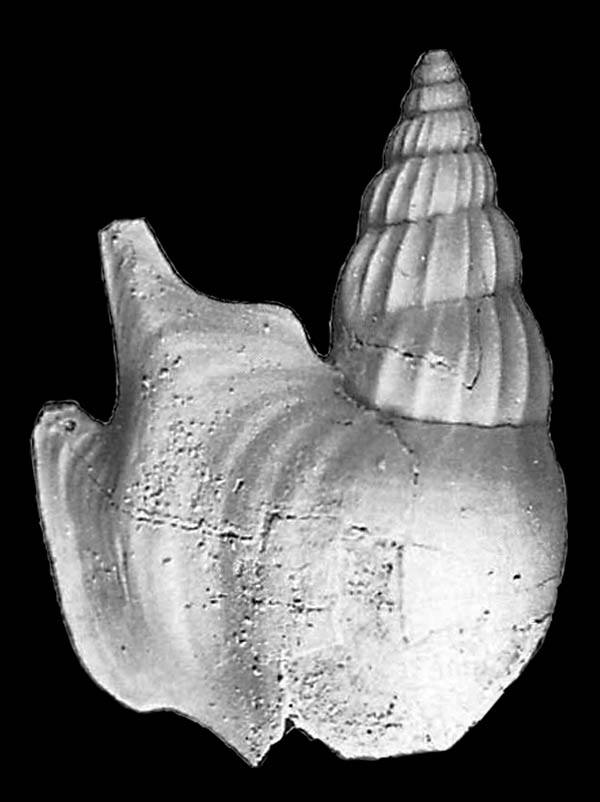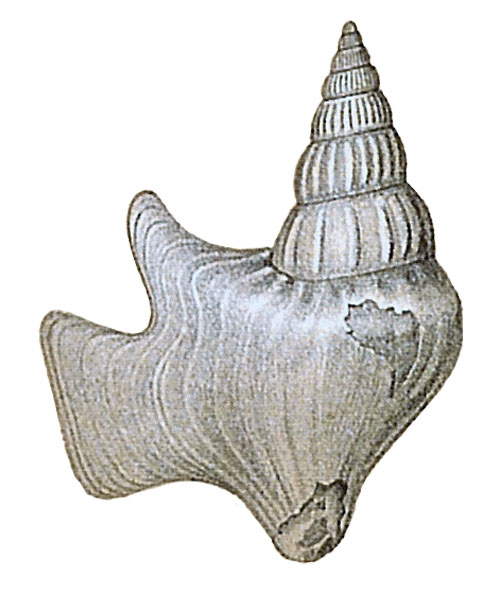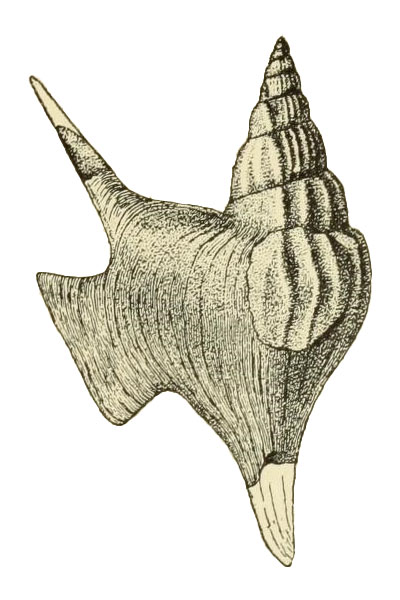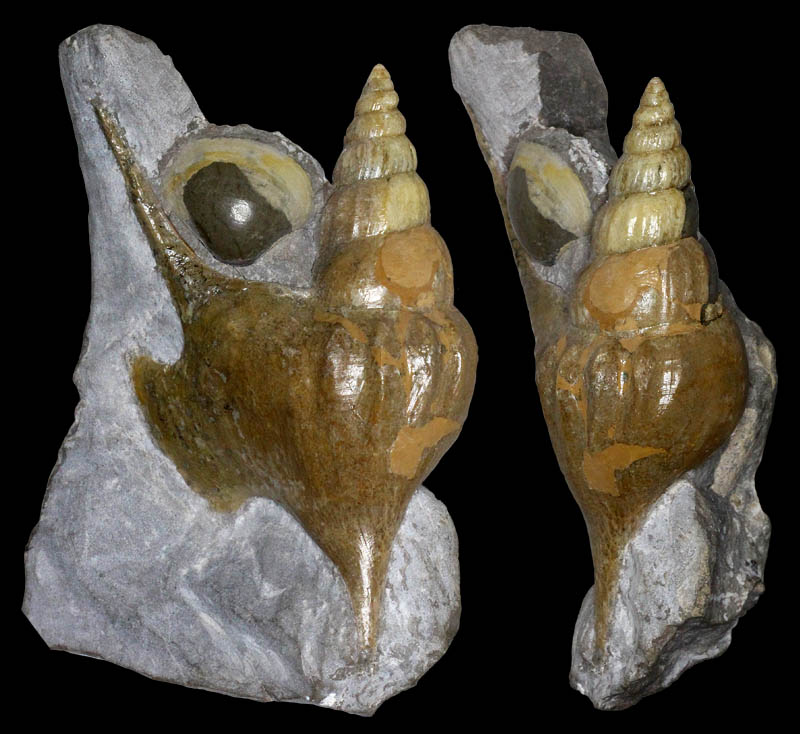|
edit SideBar
|
Species / Perissoptera Prolabiata
Stromboidea
Original Description of Anchura prolabiata by White, 1876, p. 121:
- "Shell rather above medium size, subfusiform; spire elongated and tapering, with nearly straight sides, to a point; volutions, nine or ten, convex, the last one proportionally more enlarged than the others; suture impressed; wing large, broad, its outer border nearly straight or sliglitly convex, its anterior and posterior corners abruptly rounded; posterior border bearing a strong, broad, blunt process about midway between the spire and the outer margin of the wing, the outer margin of the process having a direction parallel with that of the outer margin of the wing; posterior border of the wing concave between the outer corner and the base of the process, and also regularly and continuously concave from the spire to the end of the process; anterior border of the wing broadly and regularly concave to the base of the anterior canal, which is apparently rather short. Inner lip unknown. Surface of the volutions of the spire marked by numerous vertical or slightly oblique folds or ridges, which disappear upon the body volution and wing; these folds are crossed by numerous fine revolving raised lines, which are hardly visible without the aid of a lens, except those adjacent to the sutures, which are stronger ; these revolving lines are perceptible upon the body volution, but are very faint upon the wing. No revolving ridge passes out upon the wing from the body volution, such as is common upon shells of this genus. Length about four and a half centimeters; breadth, measured across."
Locus typicus: upper Kanab and Sink Spring, Kane County, Utah, USA
Stratum typicum: late Cenomanian Tropic Shale, Cretaceous (Dockery, 1993)
History and Synonymy
1878
Anchura (Drepanocheilus) prolabiata in White, 1878, pl. 7, fig. 2
1894
Aporrhais (Perissoptera?) prolabiata in Stanton, 1894, pl. 31, fig. 2
1993
Original Description of Perissoptera prolabiata mississippiensis by Dockery, 1993, p. 60:
- "Diagnosis: Medium sized, axially ribbed, turriculate aporrhaid with a glossy shell and a broad bilobate outer lip with upper lobe long, narrow, and posteriorly directed."
- "Description: The protoconch is large and conical, consisting of five convex, smooth and glossy whorls and a varix at its terminus. The teleoconch has five and one half glossy whorls that are axially ribbed on the spire and smooth on the body whorl. Axial ribs are slighdy opisthocline and extend from suture to suture; fifteen are present on the penultimate whorl. The outer lip is smooth except for low growth ridges and is bilobate along the posterior margin with both lobes having posteriorly extended projections. The base is thin shelled and is in complete on both specimens at hand."
- Discussion: This species differs from Perissoptera prolabiata s.s. (=Anchura prolabiata White, 1876) in having fewer whorls (teleoconch with five rather than nine or ten whorls), in lacking a deep sinus at the base of the outer lip, and in having a smooth rather than axially ribbed body whorl.
- Measurements: The holotype, which has an incomplete base, measures 37.5 mm in height (incomplete) and 28.5 mm in width including the outer lip. The greatest diameter of the body whorl is 13.3 mm.
- Types: Holotype 456996 USNM.
- Etymology: Named for the State of Mississippi.
- Occurrence: Coffee Sand, MGS localities 128 and 129.
 Perissoptera prolabiata mississippiensis Dockery III, 1993; pl. 14, fig. 1; Holotype 456996 USNM
Specimens from private collections
Perissoptera prolabiata (White, 1876); Tropic Shale, Cenomanian, upper Cretaceous; Utah, USA
References
- W.A. Cobban, 1977. Characteristic Marine Molluscan Fossils from the Dakota Sandstone and intertongued Mancos Shale, West-Central New Mexico; Geological Survey Professional Paper 1009; U.S. Government Printing Office, Washington; pp. 1-30, pls. 1-21, Fulltext
- C.H. Dane, W.G. Pierce & J.B. Seeside, 1937. The Stratigraphy of the upper Cretaceous rocks north of the Arkansas river in eastern Colorado; Geological Survey Professional Paper 186-K, United States Government Printing Office, Washington; pp. 207-232, Fulltext
- Dockery III, 1993
- J.I.Kirkland, 1996. Paleontology of the Greenhorn cyclotherm (Cretaceous: late Cenomanian to middle Turonian) at Black Mesa, northeastern Arizona; Bulletin of the New Mexico Museum of Natural History and Science 9, pp. 1-131, pl. 1-50, Fulltext
- Vega, F.J., García-Barrera, P., del Carmen Perrilliat, M., Coutiño, M.A. & Mariño-Pérez, R. (2006). El Espinal, a new plattenkalk facies locality from the Lower Cretaceous Sierra Madre Formation, Chiapas, southeastern Mexico
- White, C.A., 1876, Invertebrate paleontology of the Plateau Province, in Powell, J.W. (ed.),Report on the Geology of the Eastern Portion of the Uinta Mountains and a region of country adjacent thereto. With Atlas, Chapter 3: Washington, United States Geological and Geographical Survey of the Territories, Government Printing Office, 74-135. Fulltext
|




